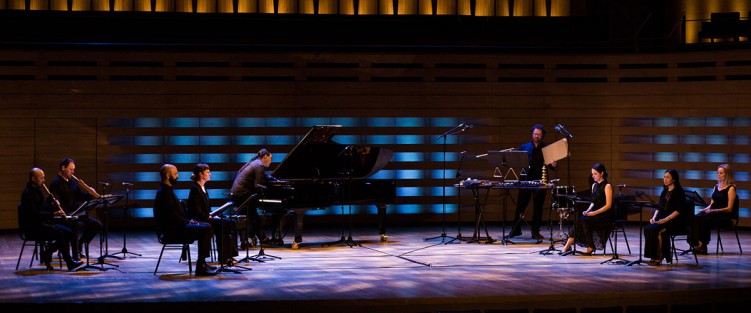 Thanks to Soundstreams and their commitment to programming Canadian music, there will be a chance to hear two works by the celebrated composer Claude Vivier on November 19, 2021, during the broadcast of a livestream concert event.
Thanks to Soundstreams and their commitment to programming Canadian music, there will be a chance to hear two works by the celebrated composer Claude Vivier on November 19, 2021, during the broadcast of a livestream concert event.
Vivier’s musical influence in Toronto stretches back to the late 1970s when his works were regularly performed by Arraymusic, and has been ongoing ever since, even though his tragic death in 1983 put an end to the creation of new works by this celebrated composer. The upcoming concert was recorded in Koerner Hall and features two works by Vivier: Love Songs (1977) and Hymnen an die Nacht (1975), as well as the world premiere of Oceano Nox by Christopher Mayo, composed as a tribute to Vivier.
I recently spoke with David Fallis, musical director of the event who offered his insights into the works being performed and the musical process the performers underwent. Love Songs was originally commissioned by Le Groupe de la Place Royale, a dance troupe formed in Montreal in 1966 that relocated to Ottawa in 1977. The company was renowned for combining theatre, dance, voice, technology and music into its productions. Although the work was originally scored for performers who were not trained singers, Fallis stated: “with some of the effects required, you do have to know what you’re doing, and certainly need to be able to keep a tune.” The score contains graphic notation, particularly where pitch is concerned, with approximate pitch notations indicating when to go up or down in register. In this production, the performers include classical singers, professional choristers and singer-songwriters: “a great mix of people”, Fallis said. Since Vivier at times doesn’t specify the pitch range or gender for the various voices, choices needed to be made by Fallis. “I tried to assign various people to specific parts that would sound effective in their voices,” he told me.
The texts Vivier used were quite varied, ranging from poetic texts by Herman Hesse and other German Romantic-influenced poets to more playful nursery rhymes such as Hickory Hickory Dock, all combining to make for a complex emotional palette. During the rehearsals, the performers experimented with how to create the necessary contrasts between the extremes of intensity and lightheartedness. This balance of contrasts was characteristic of how Vivier himself lived. As Soundstreams artistic director Lawrence Cherney wrote in a recent blog post: “Claude Vivier had the purity of a child, and as a man, he played with fire. His short life was a dangerous one, lived at the very extremes of human experience, from which he brought us back a vision of the pure sound and light of eternity.”
Love Songs has had quite a performance history in Toronto. True to the spirit of the piece, the instrumental players of the Array Ensemble took on the role of becoming vocalists during the three performances they gave in the years after the work was composed. The first was in 1978 at the Heliconian Hall, followed by a performance in 1980 at the AGO, and finally a third time after Vivier’s death in October 1983 at the Winchester Street Theatre.
“[The experience was] wonderful and wacky and inspiring,” recalls Tina Pearson, who was a guest performer for all three occasions. “The piece is a collage of vocal utterances, including invented languages, German, Latin, whispers, whistles, shouts, hums and nursery rhymes, all telling a love story of a main duo with a chorus of unruly commentators.” In March 2020, the Phth vocal ensemble from Montreal was all set to perform the piece at the Music Gallery, until the pandemic intervened and the concert was cancelled.
Oceano Nox by Christopher Mayo is composed for seven singers, piano and percussion, and is inspired by a poem by Victor Hugo. The story goes that when Vivier was in high school, he composed a work using this text, but the piece has been lost. In Mayo’s work, the poem hovers only in the atmosphere of memory and through musical quotations from two settings of the poem by little-known 19th-century composers: a choral setting by Georges Alary from 1899, and a song by Laure Collin from 1869. Although there is an allusion to the Hugo text, the singers themselves do not “sing” as usual, but rather perform by blowing and humming using a type of pitch pipe or kazoo-like instrument that works with a little slider, allowing the desired pitch to be selected before blowing. Simultaneous with blowing, the performers also hum a second pitch, thus creating harmonies with themselves. Combined with rich large chords on the piano and primarily metallophone sonorities performed by the percussionist, the overall impact of the piece brings the listener into what Fallis describes as an “out of time feeling.”
Vivier’s music always transports the listener into a world of luxurious sound and far-off imaginary places, all essential ingredients in creating what promises to be a musical evening full of sensuality and elegance.
Soundstreams presents Love Songs on November 19, 2021, at 8pm, online.
Wendalyn Bartley is a Toronto-based composer and electro-vocal sound artist. sounddreaming@gmail.com



